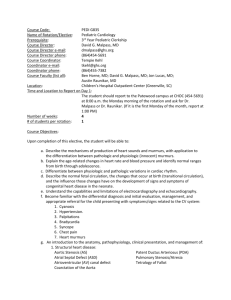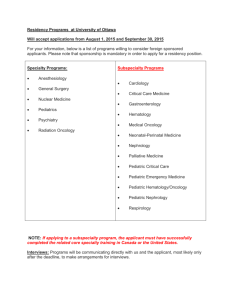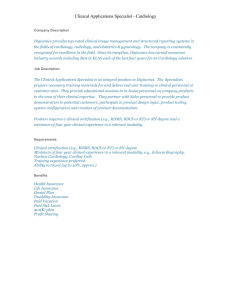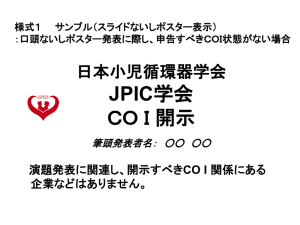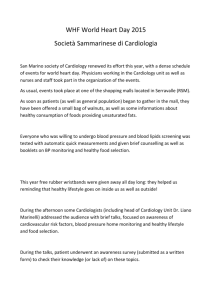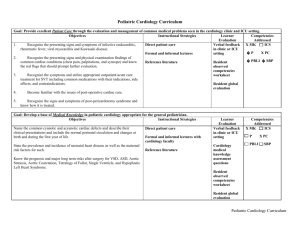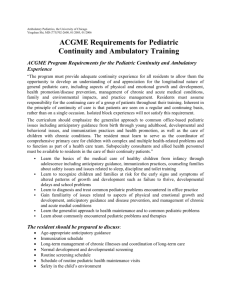Pediatric Cardiology
advertisement
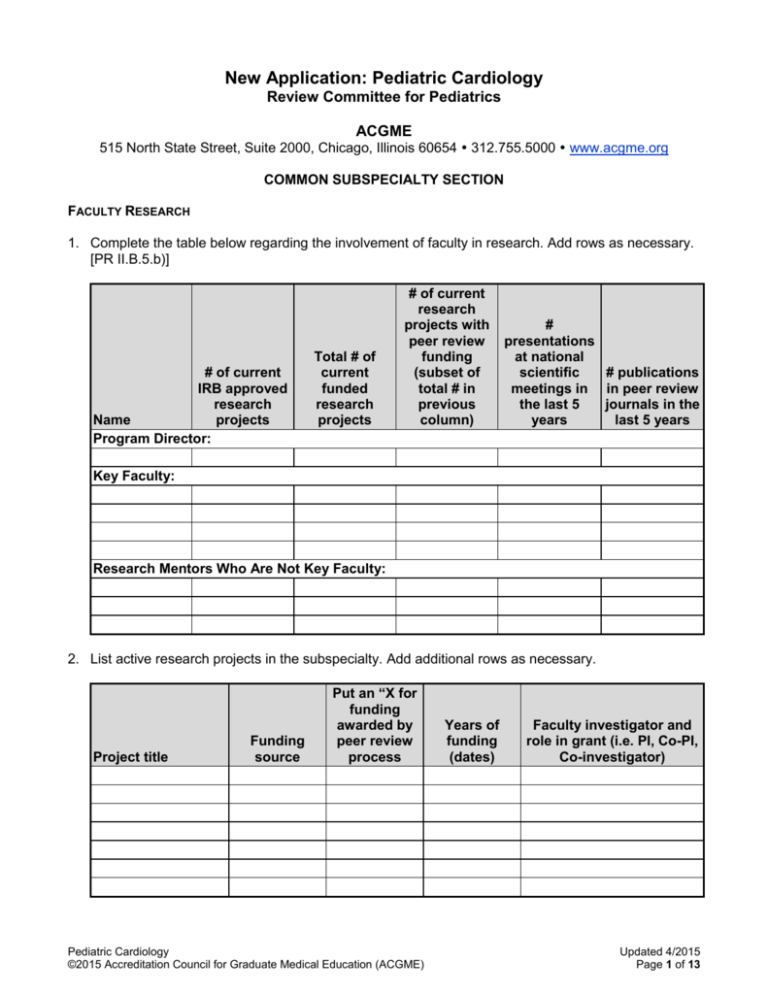
New Application: Pediatric Cardiology Review Committee for Pediatrics ACGME 515 North State Street, Suite 2000, Chicago, Illinois 60654 312.755.5000 www.acgme.org COMMON SUBSPECIALTY SECTION FACULTY RESEARCH 1. Complete the table below regarding the involvement of faculty in research. Add rows as necessary. [PR II.B.5.b)] # of current IRB approved research Name projects Program Director: Total # of current funded research projects # of current research projects with peer review funding (subset of total # in previous column) # presentations at national scientific # publications meetings in in peer review the last 5 journals in the years last 5 years Key Faculty: Research Mentors Who Are Not Key Faculty: 2. List active research projects in the subspecialty. Add additional rows as necessary. Project title Funding source Put an “X for funding awarded by peer review process Pediatric Cardiology ©2015 Accreditation Council for Graduate Medical Education (ACGME) Years of funding (dates) Faculty investigator and role in grant (i.e. PI, Co-PI, Co-investigator) Updated 4/2015 Page 1 of 13 RESEARCH RESOURCES 1. Does the program provide research laboratory space and equipment? (if appropriate) [PR II.D.] .................................................................................................................................... ☐ YES ☐ NO 2. Does the program provide financial support for research? ........................................... ☐ YES ☐ NO 3. Does the program provide computer and statistical consultation services? .................. ☐ YES ☐ NO PROGRAM CURRICULUM Goals and Objectives Place an ‘X” in the box before the applicable response. [PR IV.A.2.] Are there goals and objectives for all training ☐ YES ☐ NO experiences? Are they rotation and level specific? ☐ YES ☐ NO How are they distributed? ☐ Hard Copy ☐ Electronic or web-based If not web-based, when are they distributed to ☐ Prior to Each Rotation ☐ Annually fellows? ☐ Once in Handbook ☐ Other If not web-based, when are they distributed to ☐ Prior to Each Rotation faculty? ☐ Annually ☐ Other If web-based, do you send out reminders to access ☐ YES ☐ NO them? If yes, when do you send them? Click here to enter text. Collaboration between Programs Are there meetings among the core Program Director and subspecialty Program Directors? How often do these meetings occur? Who is typically involved in these meetings? (check all that apply) ☐ YES ☐ NO Click here to enter text. ☐ Core program director ☐ Subspecialty program director for this specialty ☐ Program directors from other subspecialties General Subspecialty Curriculum Topic e.g., Biostatistics Basic science as related to the Participants (place and X in the appropriate column) Where Taught in Number of Fellows in Curriculum? Structured this All Residents & (Name should Teaching Hours Discipline Subspecialty Subspecialty match name in Dedicated to Will Fellows Fellows conference list) Topic Area? Attend Attend Attend Research Course 14 X Click here to # ☐ ☐ ☐ enter text. Pediatric Cardiology ©2015 Accreditation Council for Graduate Medical Education (ACGME) Updated 4/2015 Page 2 of 13 Participants (place and X in the appropriate column) Where Taught in Number of Fellows in Curriculum? Structured this All Residents & (Name should Teaching Hours Discipline Subspecialty Subspecialty match name in Dedicated to Will Fellows Fellows conference list) Topic Area? Attend Attend Attend Topic application in clinical subspecialty practice Clinical subspecialty Click here to # ☐ ☐ ☐ content enter text. For the topics below, if the topic is not appropriate for your discipline (i.e., lab research for fellows in developmental and behavioral pediatrics), enter N/A into column 1. Biostatistics Click here to # ☐ ☐ ☐ enter text. Lab research Click here to # ☐ ☐ ☐ methodology (if enter text. appropriate) Clinical research Click here to # ☐ ☐ ☐ methodology enter text. Study design Click here to # ☐ ☐ ☐ enter text. Grant preparation Click here to # ☐ ☐ ☐ enter text. Preparation of Click here to # ☐ ☐ ☐ protocols for enter text. institutional review board Principles of evidenceClick here to # ☐ ☐ ☐ based medicine/ enter text. Critical literature review Quality Improvement Click here to # ☐ ☐ ☐ enter text. Teaching skills Click here to # ☐ ☐ ☐ enter text. Professionalism/Ethics Click here to # ☐ ☐ ☐ enter text. Cultural Diversity Click here to # ☐ ☐ ☐ enter text. Systems-based Click here to # ☐ ☐ ☐ practice (economics of enter text. healthcare, practice management, clinical outcomes, etc.) Conferences 1. List regular subspecialty and interdepartmental conferences, rounds, etc., that are a part of the subspecialty training program. Identify the "SITE" by using the corresponding number as appears Pediatric Cardiology ©2015 Accreditation Council for Graduate Medical Education (ACGME) Updated 4/2015 Page 3 of 13 on the first and second pages of this form. Indicate the frequency, e.g., weekly, monthly, etc., and whether conference attendance is required (R) or optional (0). List the planned role of the fellow in this activity (e.g., conducts conference, presents case and participates in discussion, case presentation only, participation limited to Q&A component, etc.). Add rows as necessary. Conference Site # Frequency R/O Role of the Fellow 2. Describe the mechanism that will be used to ensure fellow attendance at required conferences. State the degree to which faculty attendance is expected, and how this will be monitored. Limit the response to 50 words Click here to enter text. Scholarship Oversight Committee 1. Will there be a scholarship oversight committee for every fellow? ................................ ☐ YES ☐ NO 2. How often will the committee meet with the fellow? ................................................... # times per year Fellow Research Activities 1. Describe how the program will ensure a meaningful supervised research experience for the fellows, beginning in their first year and extending throughout their training. Click here to enter text. 2. If faculty outside the division will be actively involved in mentoring the fellows, identify the mentors and describe how liaisons will be created between these mentors and the fellows that allows for meaningful accomplishment of research. Click here to enter text. Pediatric Cardiology ©2015 Accreditation Council for Graduate Medical Education (ACGME) Updated 4/2015 Page 4 of 13 SPECIALTY-SPECIFIC SECTION PROGRAM PERSONNEL AND RESOURCES [PR: VIII] Other Professional Personnel 1. Indicate with a check mark the personnel who will interact regularly with fellows at each participating site. [PR II.C.] Team Members Nurse Specialists trained in pediatric cardiovascular techniques Mid-Level Practitioners (e.g. clinical nurse practitioners) Social Workers Psychologists Cardiovascular Surgery PNPs or CNAs PAs working with cardiologists, cardiovascular surgeons or the heart transplant service Intensive Care Nurses Catheterization/Laboratory Technicians Site #1 Site #2 Site #3 ☐ ☐ ☐ ☐ ☐ ☐ ☐ ☐ ☐ ☐ ☐ ☐ ☐ ☐ ☐ ☐ ☐ ☐ ☐ ☐ ☐ ☐ ☐ ☐ 2. For categories of personnel that are unavailable, describe how that function will be addressed in the program. Click here to enter text. Support Facilities [PR VIII.C.5.] 1. Place a check mark in the appropriate spaces if these particular services are available at each of the participating institutions in the program. Available Available 24 Hours/Day Site #1 Site #2 Site #3 Site #1 Site #2 Site #3 1. Diagnostic imaging facilities [PR VIII.C.5.a)] a) Diagnostic b) Flat Panel Detector c) Angiocardiogram 1. Single- and Bi-plane d) Digital computerized imaging e) Cardiac MRI and/or CT scanning f) Nuclear cardiology 2. Diagnostic & Interventional cardiac catheterization laboratory facilities, including physiological equipment as follows: [PR VIII.C.5.b)] ☐ ☐ ☐ ☐ ☐ ☐ ☐ ☐ ☐ ☐ ☐ ☐ ☐ ☐ ☐ ☐ ☐ ☐ ☐ ☐ ☐ ☐ ☐ ☐ ☐ ☐ ☐ ☐ ☐ ☐ ☐ ☐ ☐ ☐ ☐ ☐ ☐ ☐ ☐ ☐ ☐ ☐ ☐ ☐ ☐ ☐ ☐ ☐ ☐ ☐ ☐ Pediatric Cardiology ©2015 Accreditation Council for Graduate Medical Education (ACGME) Updated 4/2015 Page 5 of 13 a) Blood oxygen b) Blood gas and pH analysis c) Indicator-dilution techniques d) Stress test e) Cardiac output f) Electrophysiology g). Pressure 3. Echocardiography laboratory [PR VIII.C.5.c)] a) 2D b) Doppler c) Fetal d) Transesophageal 4. Non-invasive electrophysiology laboratory with facilities for performing and interpreting [PR VIII.C.5.d)]: a) Standard b) Ambulatory c) Exercise 5. Graphics laboratory for recording Echocardiography, exercise testing, Holter monitoring, etc. 6. Operating room(s) designed for pediatric patients and equipped for cardiopulmonary extracorporeal circulation. The area must be equipped with the following [PR VIII.C.5.g)]: a) Appropriate bedside monitoring devices b) Defibrillators c) Cardiac pacing devices 7. Blood Bank [PR VIII.C.5.h)] a) Type and cross-match blood 8. CT, UFCT 9. MRI 10. Continuous bedside monitoring 11. Exercise Testing 12. Transtelephonic telemetry 13. Clinical cardiac electrophysiologic laboratory for invasive intracardiac electrophysiological studies and catheter ablation. Available Available 24 Hours/Day Site #1 Site #2 Site #3 Site #1 Site #2 Site #3 ☐ ☐ ☐ ☐ ☐ ☐ ☐ ☐ ☐ ☐ ☐ ☐ ☐ ☐ ☐ ☐ ☐ ☐ ☐ ☐ ☐ ☐ ☐ ☐ ☐ ☐ ☐ ☐ ☐ ☐ ☐ ☐ ☐ ☐ ☐ ☐ ☐ ☐ ☐ ☐ ☐ ☐ ☐ ☐ ☐ ☐ ☐ ☐ ☐ ☐ ☐ ☐ ☐ ☐ ☐ ☐ ☐ ☐ ☐ ☐ ☐ ☐ ☐ ☐ ☐ ☐ ☐ ☐ ☐ ☐ ☐ ☐ ☐ ☐ ☐ ☐ ☐ ☐ ☐ ☐ ☐ ☐ ☐ ☐ ☐ ☐ ☐ ☐ ☐ ☐ ☐ ☐ ☐ ☐ ☐ ☐ ☐ ☐ ☐ ☐ ☐ ☐ ☐ ☐ ☐ ☐ ☐ ☐ ☐ ☐ ☐ ☐ ☐ ☐ ☐ ☐ ☐ ☐ ☐ ☐ ☐ ☐ ☐ ☐ ☐ ☐ ☐ ☐ ☐ ☐ ☐ ☐ ☐ ☐ ☐ ☐ ☐ ☐ ☐ ☐ ☐ ☐ ☐ ☐ ☐ ☐ ☐ ☐ ☐ ☐ ☐ ☐ ☐ ☐ ☐ ☐ Pediatric Cardiology ©2015 Accreditation Council for Graduate Medical Education (ACGME) Updated 4/2015 Page 6 of 13 2. If NO is indicated for any of the facilities and/or services in all the institutions above, explain how the service is provided for patients. If the facility or service is concentrated in one institution, explain how patients in the other institutions access these services or facilities. Click here to enter text. Inpatient Service/Outpatient Services 1. Indicate the availability of the following by checking the appropriate box. For inpatient services, indicate the number of available beds. Facility/Service Space in an ambulatory setting for optimal evaluation and care of patients An inpatient area with full pediatric and related services (including surgery and psychiatry) staffed by pediatric residents and faculty Pediatric intensive care unit (total number of beds) Neonatal intensive care unit (total number of beds) Cardiac Intensive Care Units (total number of beds) Other intensive care units where children < 18 years are cared for (total number of beds) Site #1 Site #2 Site #3 ☐ ☐ ☐ ☐ ☐ ☐ # # # # # # # # # # # # 2. For each location listed below where postoperative care is provided, indicate the planned role of the fellow in that care for each of the following age groups: neonates, infants, children, and adolescents. Facility Inpatient Area (exclusive of intensive care) PICU NICU CICU Other ICU Role of Cardiology Fellow in Patient Care Designate as: Primary Provider (PP), Consultant (C) Click here to enter text. Click here to enter text. Click here to enter text. Click here to enter text. Click here to enter text. PATIENT POPULATION [PR VIII.C.6.] Patient Data 1. Provide the following information for the most recent 12-month period. The same timeframe should be used throughout the form. Inclusive Dates: From: Click here to enter a date. Inpatient Pediatric Cardiology ©2015 Accreditation Council for Graduate Medical Education (ACGME) To: Click here to enter a date. Site #1 Site #2 Site #3 Updated 4/2015 Page 7 of 13 Inpatient 1. Total number of admissions for whom the pediatric cardiology service assumed major clinical responsibility a) Average daily census of patients on the pediatric cardiology service b) Number of new patients admitted each year (“new” refers to those who are being seen by pediatric cardiologists for the first time) c) Average length of stay of patients on the pediatric cardiology service: 2. Number of consultations by pediatric cardiologists on other inpatients a) Are consultations provided to the NICU? (Yes or No) If yes, how many? b) Are consultations provided to the PICU? (Yes or No) If yes, how many? Ambulatory Visits 1. Is there a separate cardiology clinic? (Yes or No) 2. If not, where are the ambulatory pediatric cardiology patients seen (e.g. offices, clinics, location?) 3. Number of pediatric cardiology ambulatory visits per year available to fellows. 4. Of this number, how many are new patients? (“new” refers to those who are being seen by members of the pediatric cardiology service for the first time.): 5. Number of pediatric cardiology clinic sessions per week: Site #1 Site #2 Site #3 # # # # # # # # # Length Length Length # # # Choose an item. # Choose an item. # Choose an item. # Choose an item. # Choose an item. # Choose an item. # Site #1 Choose an item. Site #2 Choose an item. Site #3 Choose an item. Click here to enter text. Click here to enter text. Click here to enter text. # # # 1st Year: 2nd Year: 3rd Year: # # # 6. Estimate the number of pediatric cardiology clinics a fellow will attend per year in the program. 2. Provide the following information for the most recent 12-month academic or calendar year for each site used to provide a specific required experience, such as transplant, cardiology, intensive care, etc. Duplicate this table as necessary. Note the same timeframe should be used throughout the forms. Site #1 Site #2 Site #3 Name of service: Total number of fellows and residents on the service Pediatric Cardiology ©2015 Accreditation Council for Graduate Medical Education (ACGME) Updated 4/2015 Page 8 of 13 Site #1 Site #2 Site #3 Total number of admissions to the service Number of new patients admitted each year (“new” refers to those who are seen by members of the service for the first time.) Average length of stay of patients on the service Average daily census of patients on the service, including consultations Ambulatory Pediatric Cardiology Experience for All Years of Training Add rows as necessary. Name of Experience Use Site/Other Setting Identifier Duration of Experience (in wks/yr) Number of Sessions Per Week Per Fellow Role of Fellow in Care of Patients – Designate as Number of Number of Primary Average New Return Provider Number Patients Per Patients Per (PP) or Teaching Fellow Per Fellow Per Consultant Attending Session Session (C) Per Session List of Diagnoses List 150 consecutive admissions (A) and consultations (C) by the Pediatric Cardiology service. Identify the time period during which these admissions/consultations occurred. The date range should occur within the same 12-month period used in previous sections. The dates must begin on the date the first patient on the list was admitted and end with the date the 150th patient was admitted, (e.g., July 1, 2014 through October 20, 2014). Submit a separate list for each site that provides required rotations. Add tables as necessary. Site Name: Inclusive Dates: Patient ID Number Age From (mm/dd/yy): Cardiac Diagnosis Pediatric Cardiology ©2015 Accreditation Council for Graduate Medical Education (ACGME) To (mm/dd/yy): Major Cardiac/Surgical Procedure(s) Updated 4/2015 Page 9 of 13 Patient ID Number Age Cardiac Diagnosis Major Cardiac/Surgical Procedure(s) Pediatric Cardiology Surgical Statistics List 150 CONSECUTIVE cardiac operations on infants and children. Identify the time period during which these admissions/consultations occurred. The date range should occur within the same 12month period used in previous sections. The dates must begin on the date the first patient on the list underwent corrective heart surgery and end with the date the 150th patient underwent corrective heart surgery, (e.g., July 1, 2014 through October 20, 2014). Submit a separate list for each site that provides required rotations. Add tables as necessary. Site Name: Inclusive Dates: Patient ID Number Age From (mm/dd/yy): Primary Cardiac Diagnosis Pediatric Cardiology ©2015 Accreditation Council for Graduate Medical Education (ACGME) To (mm/dd/yy): Major Surgical Procedure(s) Updated 4/2015 Page 10 of 13 Patient ID Number Age Primary Cardiac Diagnosis Major Surgical Procedure(s) Pediatric Cardiac Catheterization Statistics Supply patient statistics in the table below. The date range should occur within the same 12-month period used in previous sections. Site #1 Number of pediatric cardiac catheterizations during this interval: Age 0 - 30 days # Age 1 - 12 months # 13 months - 16 years # Over 16 years # Procedures a) Therapeutic 1. Septostomies # 2. Valvuloplasties # 3. Placement of devices # b) Electrophysiologic 1. Diagnostic (EPS) # 2. Therapeutic (Ablation) # c) Pacemaker placement 1. Transcutaneous # 2. Permanent # Site #2 Site #3 # # # # # # # # # # # # # # # # # # # # # # Pediatric Procedures Summarize the procedures available for fellow experience. Do not include procedures on a "private" or "non-teaching" service which does not involve fellows. Indicate the total number performed, and the number of deaths for each procedure (where applicable), (e.g., 12/2). This should include all procedures in the same 12-month period used on previous pages. CLOSED PROCEDURES 1. Shunts 2. PDA repair 3. Coarctation of aorta repair 4. Pulmonary artery banding OPEN PROCEDURES 1. VSD closure ≥1 month and <1 <1 month of age year of age 1-21 Years of age Total Performed/# of Total Performed/# of Total Performed/# of Deaths Deaths Deaths # # # # # # # # # # # # # Pediatric Cardiology ©2015 Accreditation Council for Graduate Medical Education (ACGME) # # Updated 4/2015 Page 11 of 13 ≥1 month and <1 <1 month of age year of age 1-21 Years of age Total Performed/# of Total Performed/# of Total Performed/# of CLOSED PROCEDURES Deaths Deaths Deaths 2. Semilunar valvotomy # # # 3. Tetralogy of Fallot repair # # # 4. Transposition repair # # # a. Simple # # # b + VSD or – VSD + PS # # # 5. Secundum ASD closure # # # 6. Primum ASD closure # # # 7. Complete AV canal – repair # # # 8. Pulm. Atresia + VSD, truncus # # # 9. Single ventricle, tricuspid # # # atresia 10. Valve replacement (aortic, # # # mitral) 11. Pacemaker implants # # # 12. Cardioverter defibrillator # # # NONINVASIVE DIAGNOSTIC PROCEDURES 1. ECG 2. Fetal echocardiogram 3. Transesophageal echocardiogram 4. 2-dimensional echocardiogram 5. Nuclear medicine procedures 6. Stress tests with ECG monitoring 7. Ambulatory ECG Monitoring (Holter, Event) 0-30 Days of Age Total Performed # # # 1-12 Months of Age Total Performed # 1-21 Years of Age Total Performed # # # # # # # # # # # # # EDUCATIONAL PROGRAM [PR IX.] Inpatient Experiences 1. Describe the responsibilities that fellows will have for inpatients and how and by whom they will be supervised. Limit the response to 100 words Click here to enter text. 2. State how many hours per week fellows will participate in rounds with faculty. Describe the fellow’s role in rounds. Limit the response to 100 words Click here to enter text. Pediatric Cardiology ©2015 Accreditation Council for Graduate Medical Education (ACGME) Updated 4/2015 Page 12 of 13 Outpatient Experiences (If applicable) 1. Describe the responsibilities that fellows will have for outpatients and how and by whom fellows will be supervised. Limit the response to 100 words Click here to enter text. 2. Describe the continuity of care experience fellows will receive during their period of assignment to the outpatient clinic. To what extent will they have the opportunity to provide outpatient care for patients whom they treated on the inpatient service? [PR IX.A.6.a)] Limit the response to 100 words Click here to enter text. 3. Describe the planned program learning activities which will provide experience in the general competencies for residents. Examples of learning activities include: didactic lecture, assigned reading, seminar, self-directed learning module, conference, small group discussion, workshop, online module, journal club, project, case discussion, one-on-one mentoring. Click here to enter text. IF THERE ARE ANY UNIQUE SCENARIOS OCCURRING IN THE PROGRAM THAT DO NOT FIT WITHIN THE CONFINES OF THIS FORM, PLEASE EXPLAIN. Click here to enter text. Pediatric Cardiology ©2015 Accreditation Council for Graduate Medical Education (ACGME) Updated 4/2015 Page 13 of 13

